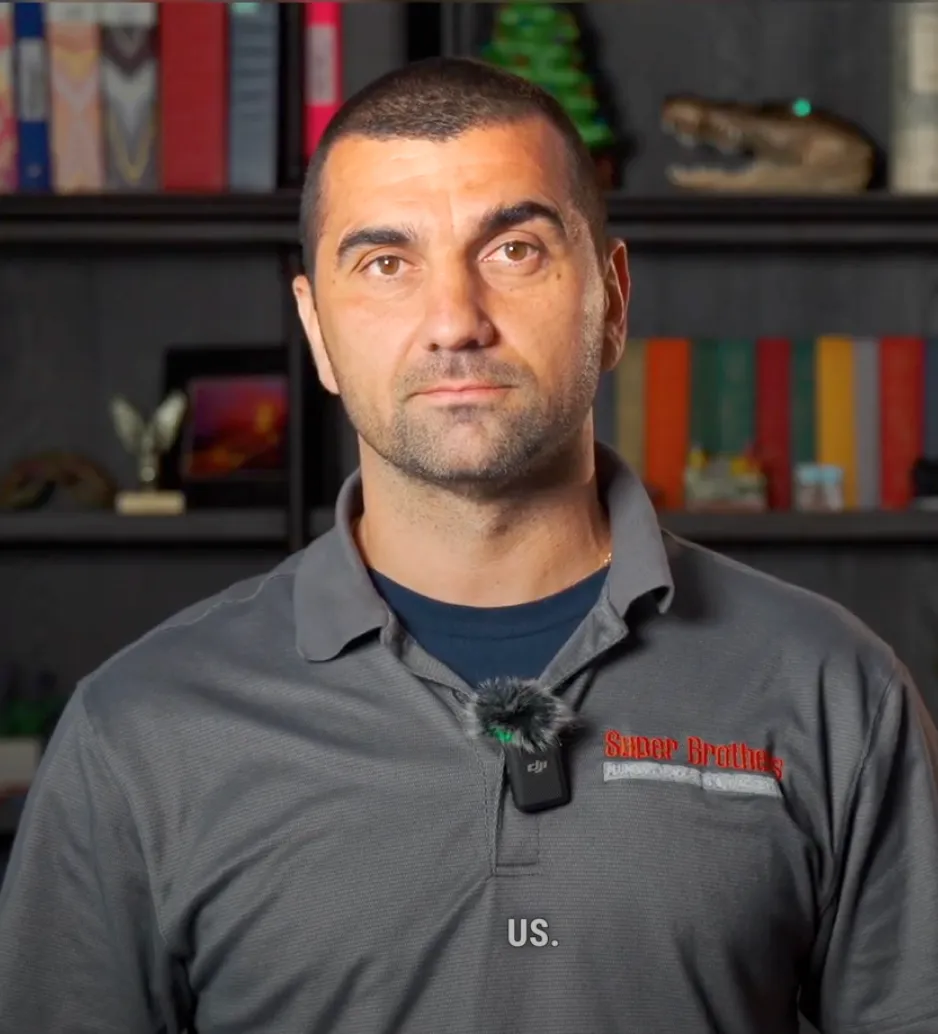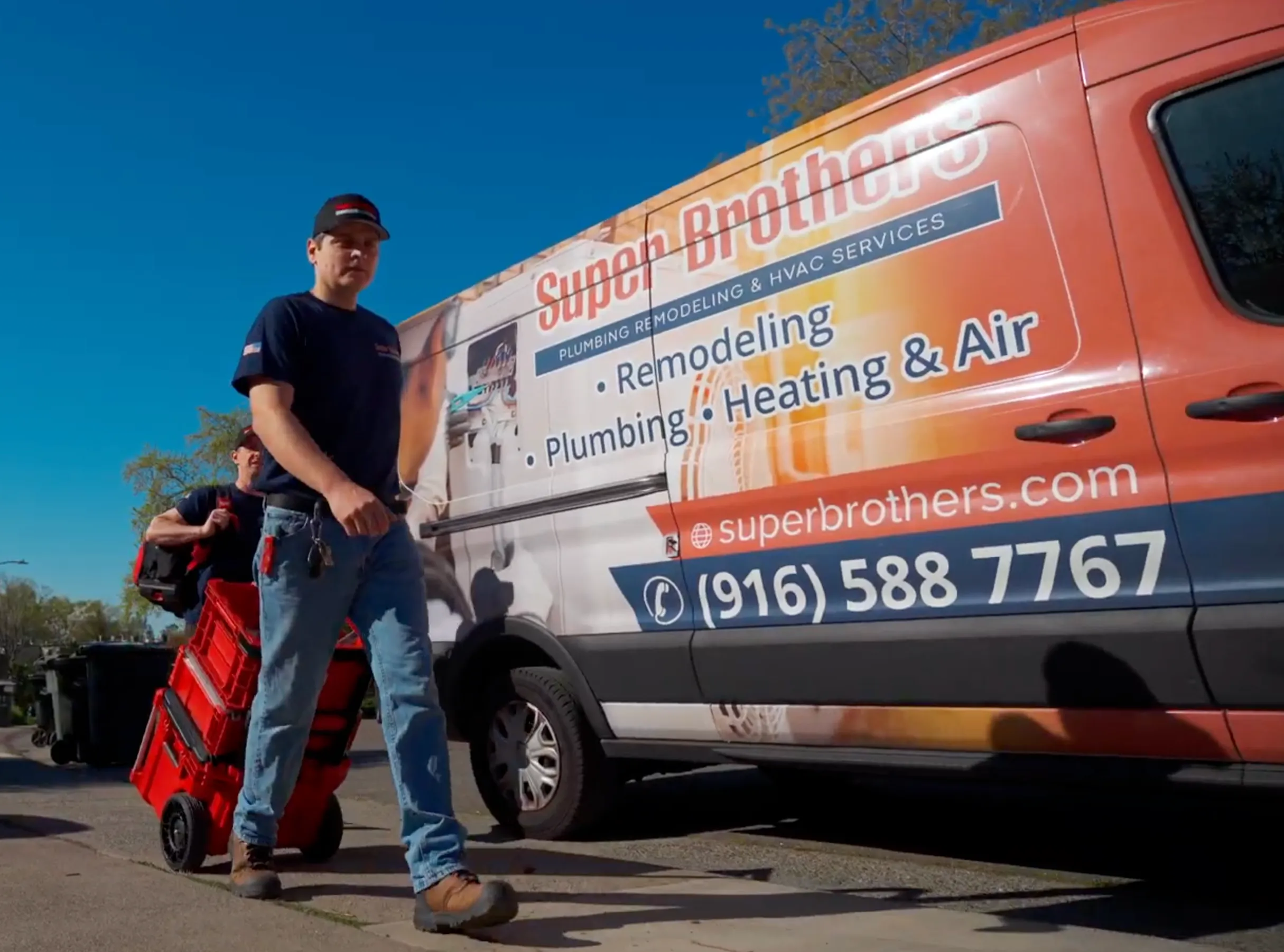Tired of waiting for hot water? Want to save on energy bills and free up some space in your homes? Consider installing a tankless water heater system. Unlike traditional electric water heaters, tankless water heaters are more energy efficient and take up less space, making them a great choice for homeowners. Tankless water heaters are the ideal solution for homeowners looking to upgrade their homes with efficient and cost-effective natural gas condensing technology. But how does tankless hot water heater installation for natural gas work, and what is the average cost of installation for this project?
Tankless water heaters work by providing hot water on demand, eliminating the need for a storage tank. This temperature control feature makes them an efficient option for any project that requires a constant supply of hot water. Additionally, tankless water heaters are a cost-effective solution that can save you money in the long run, making them an attractive advertisement for homeowners and businesses alike. Tankless units not only provide convenience but also boast energy efficiency and space-saving benefits compared to traditional water heaters. With a tankless system, you can enjoy these advantages during the tankless installation process, eliminating the need for a storage tank. If you’re considering adding a tankless water heater to your home, it’s essential to understand the installation process and associated costs. This project will help regulate the temperature of your water efficiently and save you money in the long run. Additionally, it’s important to consider the style of the tankless water heater, as it may impact its advertisement and overall appeal in your home.
So, whether you’re looking to upgrade your current system or exploring options for a new construction project, join us as we explore everything you need to know about tankless hot water heater installation, including advertisement. Get ready to make an informed decision about your water softener project that will have a lasting impact on your comfort and wallet. Whether you’re considering an advertisement for electric water heaters or other options, it’s important to choose wisely.
Deciding on a Tankless Water Heater
Consider Your Hot Water Needs
To determine the appropriate size and capacity of a tankless water heater for your household, it’s essential to consider your hot water needs. This is especially important when considering an advertisement for a tankless water heater. Take into account factors such as the number of people in your home, peak usage times, and simultaneous hot water demands when considering tankless heater installation or storage tank options. By understanding your specific requirements, you can ensure that the tankless water heater you choose will provide an adequate supply of hot water without any interruptions.
Evaluate Fuel Options
When deciding on a tankless water heater, it’s crucial to evaluate the available fuel options: gas or electric. Consider the availability and cost of each fuel type in your area when deciding on a tankless water heater installation. Whether you choose a traditional style water heater or opt for a modern house tankless water heater, it’s important to factor in the specific requirements of tankless heater installation. Gas-powered tankless water heaters tend to be more efficient than their electric counterparts, making them a popular choice for larger households with higher hot water demands. However, electric tankless water heaters may be more suitable for smaller households or areas where gas is not readily accessible.
Research Different Brands and Models
Once you’ve determined the size and fuel type for your tankless water heater, it’s time to research different brands and models. Look for reliable manufacturers known for producing high-quality tankless water heaters. Read customer reviews and ratings to gauge user satisfaction and reliability of tankless water heaters. Consider the tankless heater style water heater for its cost-effective features. Also, take into account the tankless water heater cost and installation cost when making your decision. Consider factors such as warranty coverage, energy efficiency ratings (Energy Star certification), ease of installation, maintenance requirements, and style of water heater tank. By conducting thorough research, you can find a tankless water heater that meets your specific needs while ensuring long-term durability.
When researching different brands and models of tankless water heaters, keep in mind that there are various types available on the market. Some heat units are designed for whole-house applications, while others are better suited for point-of-use installations in specific areas like bathrooms or kitchens with a tank.
It’s also worth noting that some newer models for tankless water heater installation come equipped with advanced features such as digital controls, self-modulating technology, and even Wi-Fi connectivity for remote monitoring and control. These additional heat features may enhance convenience and energy efficiency, but they can also increase the overall cost of the tank unit.
Understanding Tankless Water Heater Costs
It’s essential to consider the costs associated with installation. While the initial cost of a tankless water heater is higher than that of a conventional unit, there are long-term energy savings that can offset this expense.
Higher Initial Cost, Long-Term Savings
Tankless water heaters typically have a higher upfront cost compared to traditional units. This is due to their advanced technology and energy-efficient design. However, these units can provide substantial energy savings over time, which can help you recoup your investment.
By heating water on-demand rather than storing it in a tank, tankless water heaters eliminate standby heat loss. This means they only use energy when hot water is needed, resulting in lower utility bills. According to the U.S. Department of Energy, homeowners can save anywhere from 8% to 34% on their energy bills by switching to a tankless system.
Additional Expenses
In addition to the initial purchase cost of the unit itself, there may be other expenses associated with installing a tankless water heater. These include:
- Installation Materials: Depending on your specific setup and requirements, you may need additional materials such as pipes, fittings, and connectors.
- Venting Systems: Tankless water heaters require proper venting systems for safe operation. Depending on your home’s layout and existing infrastructure, this may involve additional costs.
- Permits: Some local jurisdictions may require permits for installing or modifying plumbing systems. It’s important to check with your local authorities regarding any necessary permits and associated fees.
- Professional Labor Fees: Hiring a licensed plumber or contractor for installation ensures proper setup and compliance with building codes but will incur labor fees.
It’s crucial to factor in these additional expenses when budgeting for your tankless water heater installation.
Lower Maintenance Costs
One advantage of tankless water heaters is their lower maintenance costs compared to traditional units. Traditional water heaters typically require regular flushing to remove sediment buildup, which can be time-consuming and may require professional assistance.
On the other hand, tankless water heaters are less prone to sediment buildup due to their design. This means you may not need to flush them as frequently, resulting in potential cost savings over time.
While tankless water heaters do require periodic maintenance, such as descaling or inspecting the heat exchanger, these tasks are generally simpler and can often be performed by homeowners themselves.
Installation Considerations for Tankless Water Heaters
Proper Ventilation for Gas-Powered Units
Ensure that your gas-powered tankless water heater has proper ventilation to prevent carbon monoxide buildup. This is crucial for the safety of your household. Carbon monoxide is a colorless and odorless gas that can be deadly if inhaled in high concentrations. To avoid this risk, make sure the unit is installed in a well-ventilated area, ideally with direct access to outdoor air. Consult a professional installer who can assess your home’s ventilation requirements and ensure compliance with local building codes.
Electrical System Compatibility for Electric Units
If you’re considering an electric tankless water heater, it’s important to determine if your existing electrical system can support the unit or if upgrades are necessary. These units require a significant amount of power to operate efficiently. Assess the capacity of your electrical panel and consult an electrician to determine if any modifications or upgrades are needed. Upgrading your electrical system may involve increasing the panel size, installing dedicated circuits, or rewiring specific areas of your home.
Placement Considerations
When installing a tankless water heater, placement considerations play a crucial role in its performance and convenience. First, consider proximity to fixtures that will require hot water, such as showers or faucets. The closer the unit is to these fixtures, the faster hot water will reach them. Accessibility for maintenance purposes should also be taken into account. Ensure there is enough space around the unit for easy access during routine maintenance or repairs.
Ease of Installation
The ease of installation varies depending on factors such as the type of tankless water heater and the layout of your home’s plumbing system. Condensing units are typically more complex to install compared to non-condensing units due to their additional components like condensate drains and exhaust systems. If you’re unsure about tackling the installation yourself, it’s recommended to hire a professional plumber or HVAC technician who has experience with tankless water heater installations. They will ensure that the unit is installed correctly and in compliance with local building codes.
The Installation Process Explained
Installing a tankless hot water heater involves several important steps to ensure proper functionality and efficiency. A professional installer will assess your home’s plumbing system and make any necessary modifications before proceeding with the installation. Here is an overview of the installation process for both gas and electric tankless water heaters.
Assessing Plumbing System
Before installing a tankless water heater, a professional installer will evaluate your home’s plumbing system. They will check the existing pipes, water pressure, and flow rate to ensure compatibility with the new unit. If any modifications are needed, such as upgrading pipes or adding additional lines, they will be addressed at this stage.
Gas Units Venting Requirements
For gas tankless water heaters, proper venting is crucial to ensure safe operation. The installer will determine the most suitable venting method based on your home’s layout and local building codes. This may involve installing vents through walls or roofs to safely exhaust combustion gases outside.
Electrical Connections for Electric Units
Electric tankless water heaters require adequate electrical connections with dedicated circuits. The installer will assess your home’s electrical system and make sure it can handle the power demands of the unit. They may need to install new wiring or upgrade existing circuits if necessary.
Mounting the Unit
Once all necessary preparations have been made, the tankless water heater can be mounted in its designated location. This is typically done on a wall near where hot water is needed most frequently, such as in the bathroom or kitchen. The unit should be securely fastened using appropriate brackets or mounting hardware.
Connecting Water and Gas/Electrical Lines
After mounting the unit, the next step is connecting the necessary lines for water supply and either gas or electricity. For gas units, a qualified technician will connect the gas line to ensure proper fuel supply. Electric units require connecting the appropriate electrical wires according to manufacturer guidelines.
Testing for Functionality
Once all connections have been made, the installer will perform a series of tests to ensure the tankless water heater is functioning correctly. This includes checking for any leaks in the plumbing system, verifying proper gas or electrical supply, and testing the unit’s performance by running hot water at various fixtures.
Enjoying Efficient Hot Water
With the installation process complete and everything tested successfully, you can now enjoy the benefits of your new tankless hot water heater. These units provide on-demand hot water, saving energy and reducing utility costs compared to traditional storage tank heaters.
Installing a tankless hot water heater involves careful assessment of your home’s plumbing system, proper venting or electrical connections, mounting the unit securely, connecting necessary lines, and thorough testing for functionality. By following these steps, you can ensure a successful installation that provides efficient and reliable hot water for your household needs.
Financial Aspects of Tankless Water Heaters
There are several financial aspects to consider. Let’s explore these factors in more detail.
Calculate Potential Energy Savings
One of the primary benefits of a tankless water heater is its energy efficiency. Unlike traditional storage tank heaters that continuously heat and store water, tankless heaters only heat water on demand. This can result in significant energy savings over time. To determine the potential savings, you can calculate your current hot water usage and estimate how much energy a tankless heater would save compared to a conventional unit.
By analyzing your hot water consumption patterns and comparing them with the energy efficiency ratings of different models, you can estimate the amount of money you could save each year. These savings can then be used to calculate the payback period for investing in a tankless water heater.
Research Available Incentives
Before making any major purchase, it’s always wise to research available incentives that can help offset upfront costs. Many utility companies offer rebates or incentives for installing energy-efficient appliances like tankless water heaters. These programs aim to encourage homeowners to adopt greener technologies by providing financial support.
There may be federal or state tax credits available for installing energy-efficient appliances. These credits can further reduce the overall cost of purchasing and installing a tankless water heater. By taking advantage of these incentives, you can significantly lower your initial investment and shorten the payback period.
Consider Long-Term Benefits
While upfront costs may seem higher for tankless water heaters compared to traditional storage tanks, it’s essential to consider their long-term benefits. Tankless heaters have a longer lifespan than conventional units, which means fewer replacements over time. This translates into potential long-term cost savings as you won’t need to invest in new equipment as frequently.
Furthermore, installing an energy-efficient appliance like a tankless water heater can increase the value of your home. Many homebuyers are increasingly interested in energy-saving features, and having a tankless water heater can be an attractive selling point.
Not only do tankless water heaters offer financial benefits, but they also have environmental advantages. By reducing energy consumption, these units contribute to a greener planet by lowering carbon emissions and conserving natural resources.
Maintaining Your Tankless Water Heater
Regular maintenance is crucial for keeping your tankless water heater running efficiently and extending its lifespan. Here are some essential steps to maintain your tankless water heater:
Regularly flush your tankless water heater
Flushing your tankless water heater is essential to remove mineral deposits that can accumulate over time. These deposits, often caused by hard water, can hinder the performance of your unit and reduce its efficiency. Flushing involves draining the system and removing any sediment or buildup that may have accumulated in the heat exchanger. By doing this regularly, you can ensure optimal performance and prevent potential issues down the line.
Check and clean inlet screens or filters
Inlet screens or filters are designed to prevent sediment buildup from entering your tankless water heater. Over time, these screens can become clogged with debris, reducing the flow of water into the unit. It’s important to check these screens periodically and clean them if necessary. By keeping them free from blockages, you can maintain a steady flow of water into your tankless water heater and prevent any potential damage.
Schedule professional maintenance at least once a year
While regular maintenance tasks can be performed by homeowners, it’s also advisable to schedule professional maintenance at least once a year. A qualified technician will thoroughly inspect your tankless water heater, ensuring that all components are functioning properly. They will also address any issues that may arise during the inspection to keep your unit running efficiently.
During professional maintenance visits, technicians will often perform tasks such as descaling the heat exchanger to remove mineral buildup more effectively. They may also check for gas leaks or other potential safety concerns. Professional maintenance not only helps maintain optimal performance but also provides an opportunity for early detection of any problems before they escalate into major issues.
By following these maintenance guidelines, you can ensure that your tankless water heater operates efficiently and reliably throughout its lifespan. Regular flushing helps prevent mineral buildup and maintains optimal performance, while checking and cleaning inlet screens or filters prevents clogs caused by sediment. Scheduling professional maintenance at least once a year ensures that your unit is thoroughly inspected and any potential issues are addressed promptly.
Remember, a well-maintained tankless water heater not only provides you with hot water on demand but also helps save energy and reduces the risk of unexpected breakdowns. So, make sure to incorporate these maintenance tasks into your routine to keep your tankless water heater running smoothly for years to come.
Conclusion
In conclusion, installing a tankless hot water heater can be a smart investment for your home. We have explored the various factors to consider, such as the cost of installation and the benefits of energy efficiency. By understanding the installation process and the financial aspects involved, you are well-equipped to make an informed decision.
Now that you have a better grasp of tankless water heaters, it’s time to take action. Contact a professional to discuss your specific needs and get a personalized quote. Don’t hesitate to ask questions and seek recommendations from trusted sources. With the right information and guidance, you can enjoy the convenience and efficiency of a tankless hot water heater in your home.


